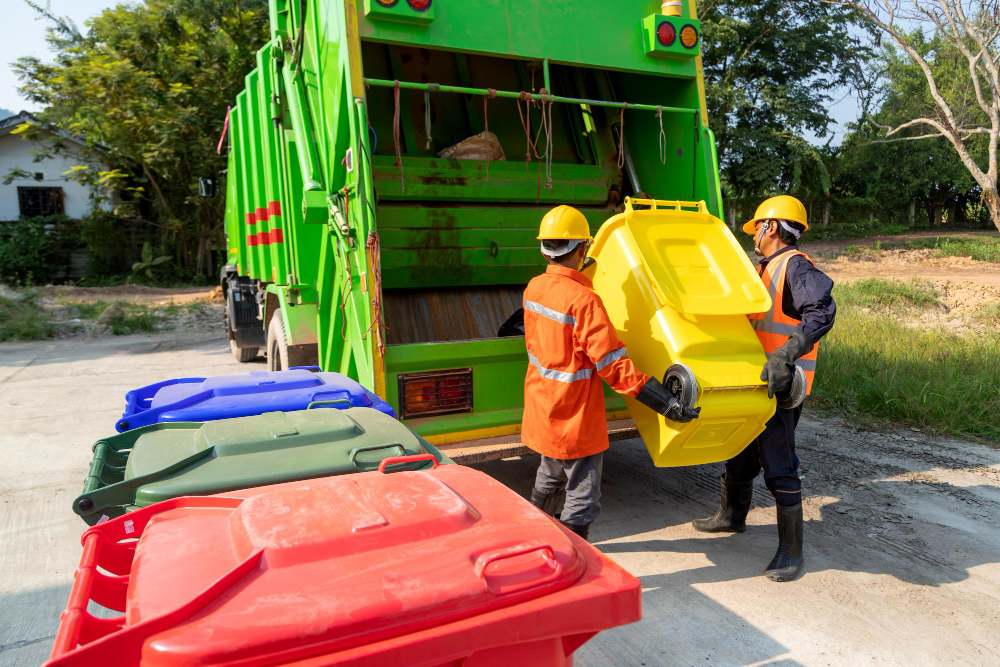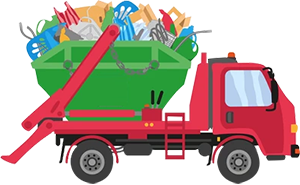What Happens to Skip Waste? Everything You Need to Know

Waste skips are crafted particularly for efficient waste management and accessibility. Meanwhile, most of us cannot make multiple visits to tip to dispose of waste if we do not avail ourselves of professional assistance. The study shows that more than 17 million skips in different sizes are hired annually in the UK for home use only.
Using a skip helps remove household waste and reduces the need for several garbage runs. However, most people still do not know what happens to their waste subsequently. Most companies collect and sort waste, finding sustainability opportunities such as reusing materials, recycling construction debris, recovering valuable items, and responsibly disposing of waste in landfills. These steps are important for reducing ecological harm.
Have you contemplated where your garbage ends up after filling a skip? Is there a proper process, and what is the best way to handle waste sustainably? This blog will explain the journey of waste from the skip to disposal in an environmentally friendly manner, concentrating on the key role of sorting.
What Happens to the Rubbish You Dispose of in Skips?
Depending on the waste disposal companies, items you put in your skip are collected. Multiple processes ensure the waste you want to eliminate is managed efficiently and responsibly.
The Sorting Process
The waste sorting process for skip contents involves separating materials into recyclable and non-recyclable categories. Preparing materials for recycling or disposal frequently involves manual sorting, robotic devices, or a combination of both.
Collection & Transportation
A sanitation company or local council picks up the filled skips and takes them to a material recycling facility (MRF) or recycling centre.
Sorting & Segregation
Manual Sorting: Skilled workers manually sort through the waste to separate recyclable materials, like wood, metal, plastic, paper, and organic matter from non-recyclable waste.
Mechanised Sorting: Automated systems and specialised machinery, like trammels, blowers, and magnets, can also be used to identify and sort different materials efficiently.
Material Categorisation: Waste is classified according to material type, including solid waste.
Examples of Sorted Materials
Recyclable Materials: Wood, metal, plastic, paper, cardboard, glass, textiles, plasterboard, green waste, soil.
Non-Recyclable Materials: Residual waste that cannot be processed further.
Hazardous Waste: Certain electrical goods, like kettles and toasters, that cannot be recycled.
Recycling Process
Skip hire companies in the UK share the same goal: to reduce the amount of waste going to landfills. After sorting, waste is taken to loading bays for treatments like compaction, shredding, and screening. Once treatment is done, we recycle or repurpose the materials, helping to create an eco-friendly waste management system that benefits everyone. This method diminishes landfill use, helps recover valuable resources, and encourages environmental responsibility in the community, promoting a circular economy.
- Manufacturers receive the sorted materials to create new products.
- For example, plastic bottles are recycled into new products, paper and cardboard are transformed into new items, and metals meltdown for new products.
- Where possible, these materials can be either reused, repurposed, or recycled.
- Waste processors use the Waste Hierarchy and other methods to reduce landfill waste.
- The non-recyclable residue is dispatched to an energy recovery facility (ERF), where it is incinerated to generate electrical or mechanical energy.
Waste to Energy
Not everything you throw away can be recycled. Some waste can rather be sent to waste-to-energy plants. At these facilities, items that cannot be recycled are burnt to generate electricity. This process significantly minimises waste that goes to landfills.
Moreover, it produces a renewable energy source, which helps to decrease dependence on fossil fuels. By utilising waste in this manner, skip hire organisations play a vital part in creating a more sustainable future.
Landfill Disposal
Non-recyclable items often end up in landfills or are disposed of through other methods. The process varies depending on local regulations and the facilities available, highlighting the importance of enhancing recycling systems to minimise waste and protect the environment.
Site Preparation: Landfill sites are designed with liners to prevent leachate from contaminating groundwater and storm water drainage systems to collect rainwater.
Waste Placement and Compaction: Waste is dumped into designated cells and compacted using heavy machinery.
Daily Cover: After each day’s waste is deposited, it is covered with a soil layer to control odours, pests, and leachate.
Leachate Management: A leachate collection system collects the liquid that drips through the waste and contains contaminants.
Methane Collection: Methane gas, produced by the decomposition of organic waste, is collected and flared (burned) or used for energy production.
Capping: Once a landfill cell is full, it is capped with a final layer of soil and a barrier layer to avoid further water infiltration and gas emissions.
Safety & Environmental Rules
- Landfills must follow strict rules to keep the air, water, and soil clean.
- Regular monitoring of leachate, methane, and air quality is conducted.
- Landfill operators must have environmental permits and follow specific design, operation, and closure guidelines.
What Items to Put in Waste Skips?
There are multiple types of skips that you can use whether you are renovating or want to get rid of unwanted items. These sizes range from small 2-yard skips to larger 40-yard skips that can handle residential, commercial, and industrial waste.
Common Acceptable Items
- Inert Waste
- Glass
- Metals
- Paper & Cardboard
- Plastics & Packaging
- Furniture & Upholstery
- Household Waste
- Garden Waste
- Construction & Building Waste
Items to Avoid Putting in a Skip
- Gas Cylinders or Aerosols
- Liquids or Oils
- Medical/Clinical Waste
- Electrical Items
- Tyres
- Contaminated Wood
- Hazardous Materials
- Mattresses

What Is the Environmental Significance of Effective Waste Management?
Managing waste is important for our beautiful planet. When businesses adopt effective garbage disposal methods, they contribute to a clean and healthy future for everyone. Let’s all work together for a sustainable environment.
Pollution Reduction
- Reduced Landfill Waste: Effective waste management, including recycling and composting, reduces the amount of waste sent to landfills, which are significant sources of methane, a potent greenhouse gas.
- Prevention of Contamination: Properly disposing of hazardous rubbish helps avoid soil and water pollution, ensuring the welfare of both individuals and our precious ecosystems.
- Cleaner Air and Water: Reducing the waste that goes to landfills and incinerators improves air and water quality.
Resource Conservation
- Less Demand for Raw Materials: Recycling and reusing materials preserve natural resources, such as trees, water, and minerals.
- Energy Savings: Recycling processes often require less energy than producing new materials from raw materials, saving energy and reducing carbon emissions.
- Preservation of Ecosystems: Waste management helps preserve biodiversity and maintain ecosystems by reducing the need for resource extraction and land for landfills.
Climate Change Mitigation
- Reduced Greenhouse Gas Emissions: Landfills produce methane, a powerful greenhouse gas, and reducing landfill waste through recycling and composting significantly lowers methane emissions, contributing to climate change mitigation.
- Less Carbon Footprint: Good waste management facilitates decarbonisation by reducing incineration and other heavy-duty waste management methods.
- Sustainable Energy Mix: Waste-to-energy plants can contribute to a more sustainable energy mix and improve air quality, promoting public health.
Key Considerations When Hiring Skips for Your Rubbish
Hiring a skip is wise for any business aiming to manage waste efficiently, particularly for larger jobs. Whether you’re involved in construction, disposing of an office, or organising an event, selecting the right skip simplifies waste disposal while promoting eco-friendliness. Here are several key considerations to ensure a seamless skip hire experience, including:
Assess Your Waste
You need to recognise the type and amount of waste to choose the right skip size.
Select Skip Size
Select from a wide range of skip sizes, including mini skips of 2-yard to 40-cubic-yard skips.
Know Permit Requirements
You must get a permit for skips on public land from your local council.
Ensure Accessibility
Make sure that the place where you want to place the skip is clear and approachable for the delivery process.
Decide Hire Duration
Most hires last one to two weeks, with possible extensions for a fee.
Compare Quotes
You should get different quotations and feedback from various companies to find the ideal deal.
Understand Disposal Methods
It is necessary to ask about the company’s waste disposal practices and recycling policies.
Pick Alpha Skip Hire for a Safe Waste Disposal
The journey of your skip waste extends far beyond its departure from your driveway. It embarks on a transformative path through sorting and recycling processes before potentially being converted into energy or, as a last resort, finding its way to a landfill. For eco-friendly waste disposal, be it at a residential or commercial site, we are your top choice. Our team is dedicated to finding innovative methods to reduce your carbon footprint and keep more of your waste out of landfills.
With over two decades of experience, we know the locals’ requirements well and suggest the ideal skip based on our client’s needs and preferences. You can reach out to us by filling out the form or calling or emailing us with any query, concern, or request to hire skips.


